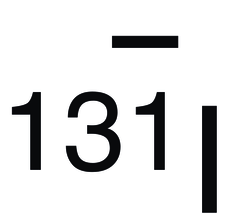Unsealed source radiotherapy
| Unsealed source radiotherapy | |
|---|---|
| Intervention | |
 | |
| ICD-9-CM | 92.28 |
Unsealed source radiotherapy relates to the use of soluble forms of radioactive substances which are administered to the body by injection or ingestion. Such substances are typically used for their biological properties, which are similar to their non-radioactive parent substance.
Sealed-source therapy, in which the radioisotope remains in a capsule or metal wire during therapy and is never allowed to dissolve in fluids, is usually referred to as brachytherapy.
Iodine
For example, iodine is an element selectively taken up by the thyroid gland in healthy people. Thyroid disease (both benign conditions like thyrotoxicosis and malignant conditions like papillary thyroid cancer) can be treated with radioactive iodine (iodine-131) which is then concentrated into the thyroid. Iodine-131 produces beta and gamma radiation. The beta radiation released destroys thyroid tissue, and any thyroid cancer that takes up iodine whilst most of the gamma radiation escapes the patient's body.
Most of the iodine not taken up by thyroid tissue is excreted through the kidneys into the urine. After radioactive iodine treatment, the urine will be radioactive or 'hot', and the patients themselves will also emit gamma radiation. Depending on the amount of radioactivity administered, it can take days to weeks for the radioactivity to reduce to the point where the patient is not a radiation danger to bystanders. There are strict radiation protection regulations governing the use of these sources.
Other unsealed sources
Other unsealed sources include:
| Isotope | Use | Description |
|---|---|---|
| 131I-MIBG (metaiodobenzylguanidine) | for the treatment of phaeochromocytoma and neuroblastoma | |
| 32P | for overactive bone marrow | the main place of use of phosphorus is the bone marrow |
| 223Ra, 89Sr & 153Sm | for secondary cancer in the bones | radium and strontium behaves calcium and samarium is bound to EDTMP |
| 90Y | radiosynovectomy in the knee joint |
Experimental antibody based methods - alpha emitters
At the ITU work is being done on Alpha-Immunotherapy, this is an experimental method where antibodies bearing alpha isotopes are used. Bismuth-213 is one of the isotopes which has been used. This is made by the alpha decay of Ac-225. The generation of one short-lived isotope from longer lived isotope is a useful method of providing a portable supply of a short-lived isotope. This is similar to the generation of technetium-99m by a technetium cow. The actinium-225 is made by the irradiation of radium-226 with a cyclotron.
References
External links
| ||||||||||||||||||||||||||||||||||||||||||||||